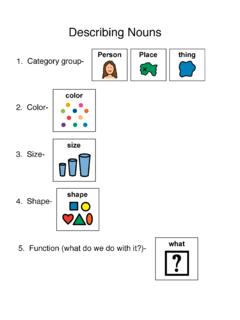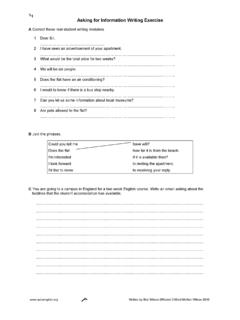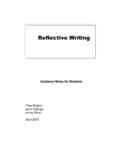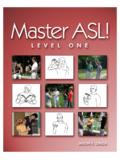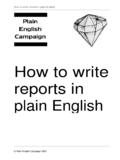Transcription of DYSPHAGIA GOALS - speakingofspeech.info
1 DYSPHAGIA GOALS LONG TERM GOALS - SWALLOWING - Client will maintain adequate hydration/nutrition with optimum safety and efficiency of swallowing function on intake without overt signs and symptoms of aspiration for the highest appropriate diet level - Client will utilize compensatory strategies with optimum safety and efficiency of swallowing function on intake without overt signs and symptoms of aspiration for the highest appropriate diet level SHORT TERM GOALS - SWALLOWING Mastication - Patient will masticate food adequately to safely consume ____(regular, mechanical soft, pureed, etc.) diet with ___%verbal, visual and tactile cues Jaw Coordination/Sensation - The patient will complete daily oral-motor exercise to increase buccal tension to within functional limits to eliminate pocketing of food in the anterior and lateral sulci with ___% verbal, visual and tactile cues and ___% effectiveness - The patient will complete daily oral-motor exercise to increase improve jaw closure and reduce anterior loss to keep food/liquid in the mouth while eating with ___% verbal, visual and tactile cues and ___% effectiveness Oral Coordination/ Sensation - Patient will complete daily oral-motor exercise to increase oral sensitivity to a functional level for bolus formation and optimum safety with__% verbal.
2 Tactile and visual cues with ___% effectiveness - The patient will demonstrate a swallow delay of only 1-2 seconds following thermal gustatory stimulation on 10/10 therapeutic trials to reduce the risk of food residue falling into the airway Lip Coordination/Sensation - The patient will complete daily oral-motor exercise to increase labial function with__% verbal, tactile and visual cues with ___% effectiveness to prevent food or liquid spillage from the oral cavity Lingual Coordination/Sensation - The patient will complete daily oral-motor exercise to increase lingual range of motion, strength and coordination with__% verbal, tactile and visual cues with ___% effectiveness for effective bolus formation and to reduce the risk of food residue falling into the airway - The patient will complete daily oral-motor exercise to increase lingual strength and range of motion for adequate lingual elevation and anterior to posterior movement with__% verbal, tactile and visual cues with ___% effectiveness to reduce the risk of food residue falling into the airway Diet Trials The patient will demonstrate diet upgrade trials without signs and/or symptoms of aspiration with 10/10 trials Techniques - Patient will demonstrate adequate use of _____technique (supraglottic swallow, Mendelson maneuver, effortful swallow, etc.)
3 To eliminate s/s of laryngeal penetration and/or aspiration of _____ (pureed, mechanical soft, etc.) diet/___liquids with ___% verbal cues during 80% of (8 out of 10 swallows) therapeutic trials. Initiation - The patient will demonstrate a swallow delay of only 1-2 seconds following thermal tactile stimulation on 10/10 therapeutic trials to decrease aspiration risk Compensatory - Patient will demonstrate adequate use of the following compensatory strategies (chin tuck, multiple swallows, head turn, etc.) to eliminate s/s of laryngeal penetration and/or aspiration of _____ (pureed, mechanical soft, etc.) diet/___liquids with ___% verbal cues during 80% of (8 out of 10 swallows) therapeutic trials. - The client will demonstrate the ability to adequately self-monitor swallowing skills and perform appropriate compensatory techniques to reduce s/s of aspiration - The patient will alternate liquids-solids bites to clear stasis through buccal cavity of residue with ___%visual, verbal and tactile cues LANGUAGE, COGNITION, TBI & DEMENTIA LONG-TERM GOALS - COGNITIVE FUNCTIONS/ COMMUNICATION - Client will develop functional, cognitive-linguistic-based skills and utilize compensatory strategies to communicate wants and needs effectively, maintain safety during ADL s and participate socially in functional living environment SHORT TERM GOALS - ORIENTATION - Client will use external memory aids and compensatory strategies to recall routine.
4 Personal information and recent events to improve orientation to time & recall daily events with ___% accuracy and ___cues. - Client will improve orientation by communicating mental awareness of daily routines, personal information and recent events with ___% accuracy and ___cues. SHORT TERM GOALS - ATTENTION - The patient will complete a _____ (sustained, selective, alternating , divided) attention task with no more than x number of redirections when given min ____ (verbal, visual, tactile) cues with x% accuracy. - The patient will demonstrate adequate attention to therapy tasks with no more than ___number of redirections in a 45-60 min session when given min ____ cues with x% accuracy. - The patient will attend to therapy tasks for x number of minutes when given no more than x number of redirections with x% accuracy SHORT TERM GOALS - SEQUENCING - The patient will verbally communicate sequences/steps and perform multi-level daily living tasks with ___% verbal, visual and tactile cues in order to complete activities of daily living SHORT TERM GOALS AUDITORY COMPREHENSION Auditory Comprehension - The patient will demonstrate the ability to comprehend utilizing verbal presentation of ____( , open-ended questions)
5 With ___% verbal, visual and tactile cues in functional living environment - The patient will gesture appropriate use of functional items with ____%visual, verbal and tactile cues in order to increase gestural expression of wants and needs in functional living environment Following Directions - The patient will demonstrate the ability to follow multi-step directions related to functional living environment with ___%verbal, visual and tactile cues in order to increase functional integration into environment SHORT TERM GOALS PROBLEM SOLVING/ SAFETY - The patient will demonstrate functional problem solving and safety awareness with ___% verbal, tactile and visual cues for daily living tasks in order to increase safe interaction with environment and decreased assistance from caregivers - Client will complete simple/ complex reasoning tasks to improve problem solving and safety awareness with ___% accuracy and ___cues - Client will complete convergent categorization tasks with ____% accuracy & ___% cues LONG TERM GOALS MEMORY & SPACED RETRIEVAL - The client will use appropriate memory strategies to schedule and recall weekly activities, express needs and recall names to maintain safety and participate socially in functional living environment SHORT TERM GOALS MEMORY & SPACED RETRIEVAL - The patient will demonstrate recall of functional information following a/an (immediate, short-term, long-term)
6 Delay with ____ cues in order to increase functional integration into environment - The patient will demonstrate the ability to plan, schedule and follow through with events/ activities with ___% accuracy and ____ cues. - The patient will complete a mental manipulation task with ___% accuracy and ___cueing in order to increase functional integration into environment SHORT TERM GOALS READING COMPREHENSION - The patient will recall ____ facts from (sentence, paragraph, several paragraph, page) length material with ___% accuracy and ___cueing. - Client will demonstrate ability to follow a written script to complete functional tasks with 80% accuracy. - Client will respond to visual cues in order improve sequencing to complete daily tasks & recall directions with 80% accuracy. - Client will recall and demonstrate strategy of responding to visual cues to improve reading skills & compensate for visual deficits during activities with 80% accuracy.
7 - The client will identify (words/letters) with ___% accuracy and ___cues - The client will match (word to word, picture to word) with ____% accuracy and ___cues - SHORT TERM GOALS WRITTEN EXPRESSION - Client will trace shapes, numbers, and letters with 80% accuracy. - Client will generate name, address, and phone number in writing with 80% accuracy. Client will write steps to complete a given task with 80% accuracy. - Client will legibly/completely write lists (grocery, to do, etc.) with 80% accuracy. - Client will write a letter and address an envelope to a given person with 80% accuracy. - Client will demonstrate functional writing skills at sentence level using compensatory strategies to complete daily activities during 80% of trials LONG TERM GOALS EXPRESSIVE LANGUAGE - Client will develop functional, cognitive-linguistic-based skills and utilize compensatory strategies to communicate wants and needs effectively to different conversational partners, maintain safety and participate socially in functional living environment SHORT TERM GOALS EXPRESSIVE LANGUAGE Naming - The patient will name objects, pictures, people and/or activities verbally with ___% verbal, tactile and visual cues to improve verbalizations Sentence Production - The patient will perform sentence/phrase completion tasks related to ADL s and safety verbally with ___% visual.
8 Tactile and verbal cues to increase automatic verbalizations in functional living environment - Client will formulate sentences with given words related to his/her personal needs, ADL s and safety with ___% effectiveness. Conversation & Pragmatics - Client will initiate and maintain 1-3 conversational exchanges related to his/her personal needs with one other familiar listener with 80% accuracy. - Patient will use short phrases / 3-4 sentences to communicate memories of familiar objects and past experiences with 60% effectiveness (6 of 10) - Resident will make 10 appropriate verbal utterances during a 15 minute conversation in response to props and minimal verbal cues by caregivers to reduce social isolation - Client will correctly identify and match facial expressions & body language related to moods/feelings with 80% accuracy to improve interaction & conversation with family & staff.
9 - Client will demonstrate appropriate turn taking & topic maintenance abilities during individual/group sessions with ___ cues Answering questions - The patient will respond to ____( , yes/no questions, open-ended questions) with ___% verbal, visual and tactile cues and compensatory strategies to increase communications within functional living environment Other - Client will verbally express 4 items belonging to given categories with semantic and phonemic cues with 80% accuracy. LONG TERM GOALS RIGHT HEMISPHERE CVA SPECIFIC - Client will recall and demonstrate use of compensatory strategies for L-side neglect to improve reading & writing skills in functional activities. LONG TERM GOALS TRAUMATIC BRAIN INJURY SPECIFIC - Client will learn & recall strategies to compensate for frontal lobe deficits to improve ability to participate in daily tasks & participate appropriately in conversation.
10 LONG TERM GOALS - DEMENTIA - Client will develop functional, cognitive-linguistic-based skills and utilize compensatory strategies to communicate wants and needs effectively, maintain safety during ADL s and participate socially in functional living environment Functional Maintenance Program Long Term GOALS - Resident will express wants, needs, and feelings through establishment of an effective maintenance program to maximize functional communication - Resident will appropriately interact with staff/ peers given _____ assist for initiation, turn-taking, and topic maintenance for communication - Resident will demonstrate appropriate behavior to meet needs with staff and support of communication needs SHORT TERM GOALS - DEMENTIA - Client will recall strategy of locating and utilizing personal memory book to improve orientation & reduce repetitive question asking behaviors 80% of trials.


